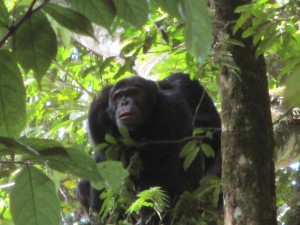 I’m writing from Gisakura, in the tea fields just outside Nyungwe National Park in Rwanda. I’m two weeks into my internship with the Wildlife Conservation Society here, where I’ve mainly been working with the education and outreach team. It has been a rich and interesting experience so far. For my next few posts, though, I’d like to write more about my first three weeks in Rwanda, traveling around the country as part of the conservation study tour led by Amy Vedder, with Yufang Gao and Lily Sweikert.
I’m writing from Gisakura, in the tea fields just outside Nyungwe National Park in Rwanda. I’m two weeks into my internship with the Wildlife Conservation Society here, where I’ve mainly been working with the education and outreach team. It has been a rich and interesting experience so far. For my next few posts, though, I’d like to write more about my first three weeks in Rwanda, traveling around the country as part of the conservation study tour led by Amy Vedder, with Yufang Gao and Lily Sweikert.
We had a wonderful (and intense) first week in Rwanda. The country is beautiful, with a striking contrast between the lush, forested park lands and rolling agricultural hills, terraced and densely populated. In our time in Nyungwe (the first of the three parks we visited) we hiked almost every day and saw some incredible wildlife, but we spent just as much (or more) time in conversation – meeting with Rwandans involved with conservation and development programs in the area. Throughout my time in Rwanda, I’ve been impressed by the dedication and enthusiasm of the people involved in conservation here: from the guys who work as tourist guides in the park (some of whom grew up near here) who can identify hundreds of birds just by their calls and who spend their free time thumbing through field guides on East African birdlife or writing books on the animals or natural history of Nyungwe, to the WCS education staff here who put in long days in the car on rough roads to visit schools in remote areas and then come home to put in even longer hours at the office. Around Nyungwe, people think a lot about how to balance conservation with the needs of local communities – the question that has interested me most in my graduate studies. It’s been exciting to hear their ideas, and to get a sense of which efforts to link conservation and development have worked here and which have not. I feel like I’m learning a lot.
One day, we woke up at 4:30 am, packed up our grilled cheese and onion sandwiches, and drove about an hour to Cyanmudongo Forest – an isolated forest patch outside of Nyungwe. Cyanmudongo is a small forest, but it is home to a group of about 30 chimpanzees that have been habituated to tourists (very difficult work, requiring daily contact, tracking the chimps through dense forest). We picked our way over thick streams of driver ants and stopped to admire mountain monkeys and Dent’s monkeys in the trees. (And on the way back up, one of our group nearly stepped on a pygmy chameleon in the trail, half a finger’s length long). All along, we could hear the not-so-distant whoops and shrieks of chimps, and, after a short while of scrambling around off trail, the forest erupted in calls and screams. We spent an hour watching the chimps in the trees, the bushes rustling on either side of us when they streaked by. It was pretty awesome. Plus we saw a black and white hornbill in the same fig tree.
Anyway, it’s all pretty new to me.
One more story: our group traveled out to a school not far from where we saw chimps to look at conservation education. The students ranged from very young (maybe around 7 or 8) to much older (over 20). Our visit became a huge spectacle: we were placed at the front of a large auditorium in front of what looked like 200 students, all staring at us. There were many speeches, and dances and songs performed by the school environmental club, as well as a skit put on by the students about conservation (which was very creative, but a bit questionable in its message: the hungry parents who wanted to poach in the park were instead given money from the suitcase of a white tourist – played by a kid in shiny shoes, who “flew” in on a rolling chair). The WCS education team was there to observe the production, to see how conservation messages were being interpreted and represented by the students. The team was really happy with the enthusiasm of both the actors and the audience, but told us that they planned to speak with the environmental club at a later point, to correct some of the details of the message (e.g., distinguishing between the revenue-sharing program—which uses the money from tourism in the national parks to finance community development projects—and cash handouts from moneyed tourists). During the ceremonies at the school, we were each asked to get up and introduce ourselves, and, at the end, our group was dragged up to dance in front of the students. I think we put on a good show.
After all the ceremony and speeches, the kids crowded around us, wanting to take pictures with us, to shake hands or hug—it was a surreal and overwhelming experience (especially since some of the kids were close to our age). Many also came up with hand-written notes, asking to take photos, asking how they might get to America, or explaining that a parent has died of HIV and they will have to drop out of school unless they can find money for school fees.
Like a lot of our experiences in Rwanda, it was an exciting day—and we were greeted very warmly and with a lot of enthusiasm—but it was troubling, too.